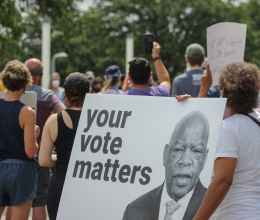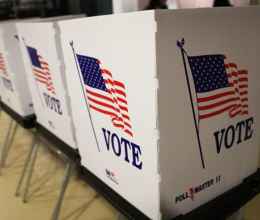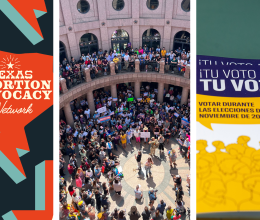
Key Resources
- For questions about voting: VoteTexas.gov
- To report difficulties while voting: 866ourvote.org (or text/call 866-687-8683)
Know Your Voting Rights
Click on one of the scenarios below to jump to the information you need:
I registered to vote, but the poll worker says I'm not on the list of registered voters
I need accommodations for my disability or limited English proficiency
Someone is interfering with my right to vote
I don't know what forms of ID I need to vote
I don't know if I'm eligible to vote
I don't know if I'm registered to vote
Which party can I vote for in a primary election or runoff?
I don’t know where I can vote
How do I vote by mail?
How do I fix an error on my mail-in ballot?
I registered to vote, but the poll worker says I'm not on the list of registered voters
Your rights
- All voters are entitled to a provisional ballot, even if they are not in the poll book. If you believe you are eligible to vote and believe you are in the right place, you can request a provisional ballot.
- After Election Day, election officials must investigate whether you are qualified to vote and registered; if you are, they must count your provisional ballot.
What to do
- Ask the poll worker to double-check for your name on the list of registered voters.
- If your name isn’t there, ask if there is a supplemental list of voters (sometimes, voters who register closer to Election Day are placed on a supplemental list of registered voters).
- You may also request that the poll workers check a statewide system, if one is available, to see if you are registered to vote at a different polling place.
- If they still can’t find your name, and you believe you are eligible to vote and in the right place, ask for a provisional ballot.
Additional information
- If you are turned away or denied a provisional ballot, you can call the Election Protection Hotline (1-866-OUR-VOTE or 1-888-VE-Y-VOTA) and the U.S. Department of Justice Voting Rights Hotline: 800-253-3931; TTY line 877-267-8971.
- You can also contact your county clerk, elections administrator, or your county voter registrar.
I need accommodations for my disability or limited English proficiency
Your rights
- Under federal law, all polling places for federal elections must be accessible to disabled and elderly voters or must provide alternate means for casting a ballot on the day of the election.
- Under federal law, all limited English proficiency voters and voters with disabilities may obtain assistance in voting from a person of their choice, as long as this person is not the voter’s employer or an agent of the employer or of the voter’s union.
- In some places (those covered by Section 203 of the Voting Rights Act), trained bilingual poll workers must be available to provide assistance in the relevant language, and ballots, written forms, and information relating to the voting process must be available in the covered language.
- All polling places for a federal election must have at least one voting system that makes voting accessible in a private and independent manner to voters with disabilities.
- Voters with disabilities cannot be turned away from the polls because a poll worker thinks they do not have the capacity to vote.
What to do
- If possible, bring a family member, friend, or another person of your choice to assist you at the polls. Don’t bring your employer or an agent of your employer or union.
- Tell the poll workers that you have chosen this person to assist you with voting. The person assisting you will be required to disclose their relationship to you and confirm that they are not being compensated for providing assistance.
- If you do not have an assistant, you may request assistance from a poll worker. Although all Texas counties must provide Spanish language materials, only some counties must provide Spanish language interpreters. Some counties provide interpretation services for other languages. You should check with your County first if you intend to rely on a poll worker for language assistance.
Someone is interfering with my right to vote
Examples of voter intimidation
- Aggressively questioning voters about their citizenship, criminal record, or other qualifications to vote, in a manner intended to interfere with the voters’ rights.
- Falsely representing oneself as an elections official.
- Spreading false information about voter requirements, such as falsely claiming that voters must be able to: speak English, vote without an assistant, or present a voter registration card.
- Displaying false or misleading signs about voter fraud and related criminal penalties
- Other forms of harassment, particularly harassment targeting non-English speakers and voters of color, including by poll watchers.
What to do if you experience voter intimidation
- You can report intimidation to the Election Protection Hotline by calling 1-866-OUR-VOTE or 1-888-VE-Y-VOTA (en Español).
- You can also contact the U.S. Department of Justice Voting Rights Hotline: 800-253-3931; TTY line 877-267-8971
- Reach out to local and state officials, including poll workers, your county clerk, elections administrator, or county voter registrar.
I don't know what forms of ID I need to vote
I’m not sure what forms of identification I need to bring to vote
You do not have to bring your voter registration card to vote. For more detailed information visit our voter identification page. The following are acceptable forms of identification:
- Texas driver license
- Election identification certificate (a photo ID for voting)
- Personal identification card from the Texas Department of Public Safety
- U.S. military ID card with your photo
- U.S. citizenship certificate with your photo
- U.S. passport
- License to carry a concealed handgun from the Texas Department of Public Safety
My identification is expired
Voters under 70 years old can use a valid photo ID that has been expired up to four years. Voters aged 70 and older can use a valid photo ID that has been expired for any length of time.
My identification lists an old address
You can still vote as long as you are registered to vote at your current address, or update your voter registration to reflect your new address (see instructions below).
I don’t have the right kind of identification
You can still vote! If you are a registered voter who couldn’t obtain one of the above forms of ID, you can still cast a regular ballot. Here's how:
- If you do not possess an acceptable ID, tell the poll worker you want to complete a “reasonable impediment declaration.” This simple document lets you explain the difficulty that prevented you from getting a photo ID. Reasonable impediments to getting a photo ID include work schedule, lack of transportation, disability or illness, family responsibilities, lost or stolen identification, lack of documents needed to obtain a photo ID, and photo ID applied for but not received.
- Fill out the form and present it to the poll worker. Poll workers can’t question or challenge you about not having a photo ID, or the reason you give on your “reasonable impediments declaration.”
- Show one of the following documents:
- Current utility bill
- Bank statement
- Paycheck
- Voter Registration Certificate
- Certified birth certificate
- Government check
- A government document that shows the voter's name and an address
I don't know if I'm eligible to vote
You are eligible to vote if:
- You are a United States citizen.
- You are a resident of the State and of the county where you are trying to vote.
- You are 18 years old (you can register to vote if you are at least 17 years and 10 months old and will be 18 on Election Day).
- You registered before the deadline — 30 days before an election in Texas.
- If you have been finally convicted of a felony, you have completed your sentence, including any term of incarceration, parole, supervision, or probation.
- You have not been declared by a court exercising probate jurisdiction to be either totally mentally incapacitated or partially mentally incapacitated without the right to vote.
I don't know if I'm registered to vote
You can check the Texas Secretary of State website to see if you are registered to vote.
I have moved or changed my name
- You can update your information when you renew your driver’s license or at the Texas Voter Registration and Name Address page.
- You can also notify the County voter registrar in writing by:
- Updating your address on the back of your current voter registration certificate
- Filling out a new voter registration application form and checking the “change” box
- You can also notify the County voter registrar in writing by:
- If you move within the county:
- If your County has county-wide voting, you can still vote at any location in your county. A list of counties with county-wide polling is available on the Texas Secretary of State's website.
- If your County does not have county-wide voting, you must vote in your precinct:
- You will be able to vote in your new precinct 30 days after you submit your address change.
- If you do not change your address 30 days before the election, you can vote in your former precinct.
- When you go to vote, inform the election workers that your address has changed and needs to be updated before you vote.
Which party can I vote for in a primary election or runoff?
- As long as you have not “affiliated” with a party that year, you may vote in either primary election – but not both. Affiliating with a party normally requires taking an oath. Also, if you signed a petition for a candidate, you can only vote in the primary of that candidate’s party. Affiliations expire at the end of the calendar year.
- During runoff elections you can only vote in the party you voted for during primary elections. For example, if you voted in the Democratic primary you can’t vote in the Republican runoff election. If you didn’t vote in the primary, you can vote in either runoff – but not both.
I don't know where I can vote
- If your county has county-wide polling, you can go anywhere in your county to vote.
- If your county does not have county-wide polling:
- You can vote anywhere in the county during early voting, but can only vote at your designated polling location on election day.
- You can find your polling location by checking your county elections website or checking the Secretary of State’s website which will list polling locations a few days before Election Day.
- A list of counties with county-wide polling is available at the Texas Secretary of State website.
How do I vote by mail?
- You are eligible to vote by mail if:
- You are sick or have a disability.
- If you are expected to give birth three weeks before or after election day.
- You are 65 years or older.
- You are confined in jail, but otherwise eligible to vote.
- You will be out of the county on election day and during the period for early voting.
- Oct. 27, 2023 is the last day for counties to receive an application to vote by mail. You may also hand deliver your marked ballot in person to the county election office on Election Day while polls are open.
- There is a new requirement in Texas that you list your driver’s license number (or personal identification number), or if you do not have that number, list the last four digits of your social security number on both your mail ballot application and mail ballot. If possible, it is recommended that you list both your driver’s license and social security number.
- To find out more about your ability to vote by mail, visit your county elections website.
- You can also find out more about the process for voting by mail (complete with a downloadable application) from the Texas Secretary of State website.
How do I fix an error on my mail-in ballot?
- You can correct ID number errors on your application or ballot, and track the status of your application or ballot, by using the Texas Secretary of State website.
- If the elections office mails you your voted ballot back with an error notice, you can correct your ballot and return it to your local elections office by 7pm on election day. You also have the option to vote in person through election day; if you don’t bring your ballot, you will need to vote a provisional ballot.
- If your ballot is rejected without being returned to you, you have six days after the election to “cure” or fix the problem.
- If you have questions about correcting your mail-in-ballot, you can contact your county clerk or elections administrator, or call the Election Protection Hotline (1-866-OUR-VOTE or 1-888-VE-Y-VOTA).





